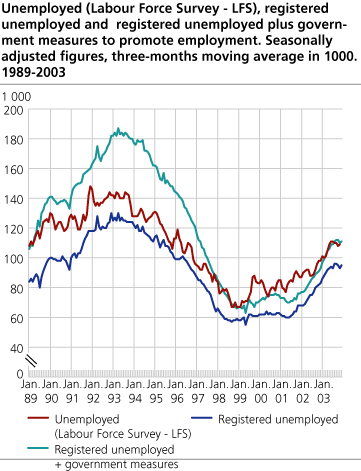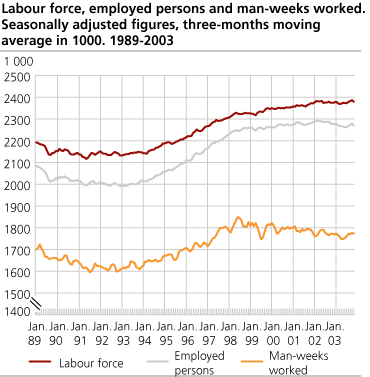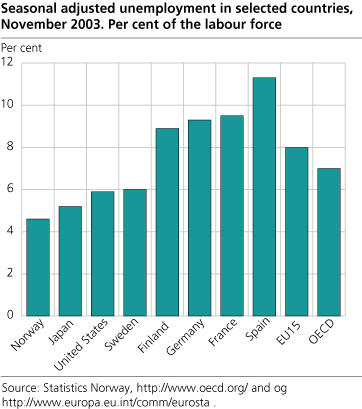Content
Published:
This is an archived release.
Minor changes in the labour market
Unemployment and employment remained more or less unchanged from August to November 2003. Man week figures also remained stable. The figures are adjusted for seasonal variations.
Since June (the May-July period) the trend has shown a decline in unemployment. The last figure for November (October-December) shows that unemployment increased by 1 000 people from the previous month. This is clearly inside the error margins, and so the increase is not inconsistent with the trend. Seasonally adjusted figures of registered unemployment at job centres revealed a slight decrease from October to November.
The summer of 2003 saw an increase in employment, but from October to November employment decreased by 9 000 people, which is still inside the error margin.
Higher unemployment in Sweden
The seasonally adjusted unemployment rate for Norway was 4.6 per cent both in November and August 2003. EU unemployment remained flat at 8.0 per cent, while the unemployment rate in OECD countries fell from 7.1 to 7.0 per cent. The USA saw unemployment fall by 0.2 percentage points to 5.9 per cent from August to November, while Sweden experienced unemployment growth from 5.6 per cent to 6.0 per cent. Unemployment went down from 9.0 to 8.9 per cent in Finland, while it remained more or less unchanged in Germany and France. This is according to figures from OECD and Eurostat .
Man-weeks worked have shown a downward trend since the summer of 1998. From August (July-September) to November (October-December) man-weeks worked increased by 2 000, which is inside the error margins.
Uncertain figures
Quality tests show that the seasonally adjusted LFS unemployment figures are uncertain. The seasonal-adjustment method has problems identifying a stable seasonal pattern for this series. The random component is relatively large compared with the seasonal component. The figures should therefore be treated with caution.
The purpose of adjusting for seasonal variations is to describe the development during the last year and to provide figures of change between the last two three-month periods, cleared for normal seasonal variations. In order to reduce uncertainty, the presented series are three-month moving averages of the seasonally adjusted figures. For instance, the figures for November are the average of the estimates for October, November and December.
Tables:
The statistics is published with Labour force survey.
Contact
-
Arbeidsmarked og lønn
E-mail: arbeidsmarked@ssb.no
-
Erik Herstad Horgen
E-mail: erik.horgen@ssb.no
tel.: (+47) 93 08 68 62



